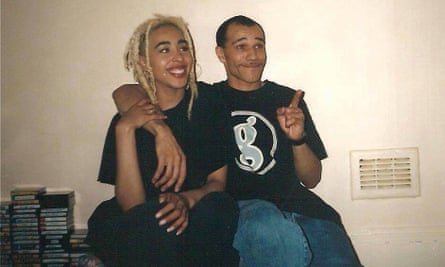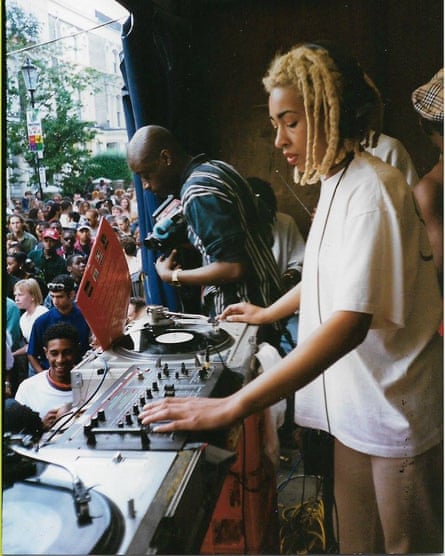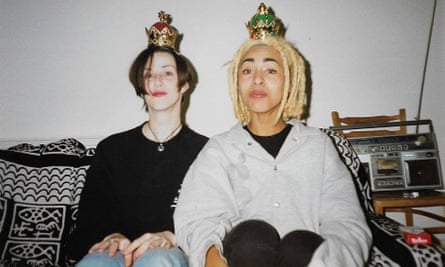Storm remembers the sound of glass shattering, but not how many seconds or minutes had passed before she realised something awful had happened. A 4.5kg metal cat’s eye had been dislodged from the road ahead by a passing van, and had smashed through their car windshield on the passenger side. It left Kemistry – her best friend and partner in one of the UK’s most pioneering drum’n’bass outfits – with devastating injuries. Minutes later, she died.
“I’ve had some really dark times and really dark thoughts,” says Storm, 20 years on from the accident. “Thoughts about me not being here, about going to join her.”
For many fans, the legacy of drum’n’bass is inextricably linked to Goldie and his mercurial energy. But it was Kemistry and Storm – his business partners for the genre’s most popular label, Metalheadz – who shaped the imprint with their collaborations and relentless work ethic. As DJs, they were pioneers in a mostly male world and their ability to mix heaving industrial rhythms and celestial minor chords set them apart. Their 1999 DJ Kicks mix is still seen as one of the genre’s most influential.
Valerie “Kemi” Olusanya was born in 1963 to a Nigerian father and white English mother. She grew up in Kettering, a south Midlands quarry town, and it’s there that she befriended Jayne Conneely, AKA Storm. “I was a new romantic and she was more new wave,” Storm recalls. “I worked in this restaurant, and she’d come in with these two guys who looked like David Sylvian from Japan. I thought: ‘Ooh, hello, I’d love to know what they’re up to.’”
One of the Sylvian replicas asked Storm on a date. He played saxophone in a nine-piece post-punk band. Kemistry was dating the keyboardist and living with them in an anarchic house. The budding romances didn’t last, but the young women became friends.
“I always thought of Kemi as this wise owl,” says Storm. “She was a Libra, so would always weigh up the scales of justice in her mind.” She notes that Kemistry had a positive outlook, but sometimes struggled. “Her father left when she was around four years old and her mum had to bring her up on her own, which was difficult,” says Storm. Kettering in the late 70s wasn’t the most open-minded of towns. “I know she got badly bullied because she was mixed-race. She didn’t want to go to school. I think racism crushed her spirit a bit.”
The pair went in different directions after they left Kettering in the mid-80s: Storm to Oxford to study radiography, Kemi primarily to Sheffield, where she studied fashion. They reunited in 1989 when Kemistry moved into a flat in Finsbury Park, north London, with some Midlands ravers. They would sit up late, reconnecting over spliffs and records that Kemistry had bought “up north”: Cabaret Voltaire and Nightmares on Wax were the rough to Storm’s smooth (she loved synth-pop and Prince). Their love of music from across the spectrum would later characterise their DJing.
After graduating from Oxford, Storm slept on a mattress on Kemistry’s floor and their weekends gathered steam. Thursdays were dedicated to Rage at Heaven with drum’n’bass progenitors Fabio and Grooverider. Fridays they would drive to Coventry to see Doc Scott play at Amnesia. Sundays were spent in warehouses around Charing Cross, listening to UK techno DJs such as Steve Bicknell. By now, they were soul sisters.

In early 1991, Kemistry met a gold-toothed guy from Wolverhampton named Clifford, who had missed much of the second summer of love doing graffiti in New York City. She agreed to go on a date on the condition that he came to Rage with her. It was his introduction to raving. Clifford – or Goldie as we would come to know him – was hooked, and envisioned a record label-as-lifestyle entity that would be “the Stüssy of hardcore”, referencing the influential streetwear brand. He would produce the music and find artists with whom he felt a kinship to release, and Kemistry and Storm would be the DJs.
By late 1991, the two women were passing their decks and mixer through a hole in the wall of a Kentish Town squat, playing the 6-9am Sunday slot on pirate radio station Touchdown FM. They were cautiously aware of sexism within the scene. When they started their show, Goldie was their MC, but it wasn’t long before he began touring and couldn’t host the broadcasts. When they moved to Defection FM, they started doing their own calls and track IDs live on air; only then did most of their listeners realise they were women.
Detail-oriented, they kept a book of every record they bought and made a résumé complete with mixtapes of their sets, which they sent to radio stations, shops and promoters. “When people phoned after they heard the tapes, I would say I was looking after these DJs rather than we were the DJs,” says Storm. “Then we’d turn up for the gig and they’d be like: ‘Oh – you’re girls? And there’s two of you!’ We only wanted to be judged on whether we were any good or not.”
Metalheadz launched in late 1994 and took over Storm and Kemistry’s lives. When they weren’t waiting at Music House in Tottenham to cut fresh dubplates, they were crouched on their bedroom floor, faxing orders around the world. Storm managed logistics and Kemistry wrote the press releases, thumbing through a thesaurus to find metal-adjacent words to describe the sounds.

Their back-to-back performances were about business, too: as one cued up a record, the other answered questions from spotters – enthusiasts keen to identify the latest dubplates. “We’d be standing there with the punters,” says Storm, laughing, “their heads going round on the dubplate and trying to glean something from it.” Goldie would even hand out notepads and pencils, so they could write down exactly what Metalheadz was going to release and when.
One of those heads was Stefan Struever, the German A&R for the !K7 label’s DJ Kicks mix-CD series. “When [Kemistry and Storm] came on, they were so dominant,” he says. “You could feel in the club that they were treated with so much respect. It was exciting, and varied: Peshay played on a jazzy note, LTJ Bukem was more atmospheric, but they had no barriers in their minds.”
They were booked for a career-building North American and central European tour to promote the release. On a flight to a gig in Florida that April, Kemistry and Storm felt a dark cloud come over them. They were tense and bickered, something they never did. They wondered what was wrong. They looked at each other and said, almost in unison: “Someone’s going to die.”
Back in London 48 hours later, they left voicemails for each other: “Hi, sorry, it’s your crap friend here. Don’t know what that was about!” They had a gig in Southampton that night. Driving home in the small hours, the uneasy sensation lingered. “Kemi said that she always felt that she was going to die young,” says Storm. “She didn’t want to be old. She said, ‘I’m going to be the Marilyn Monroe of this scene. I’m going to be notorious.’”

After the crash, Storm struggled to go on without her soul sister. She continued to live in Kemistry’s room (“That might seem perverse to people, but I needed to be surrounded by her”) and would play the answer message on their fax machine over and over, just to hear her voice. “I would think: ‘Oh my God, I didn’t save her.’ That was the most difficult part for me. Getting over the guilt of not being able to save her.”
Kemistry’s death rocked the now-global drum’n’bass scene. Their contemporaries felt the absence of a beloved originator keenly. As the time passed, those peers encouraged Storm to DJ solo and she started playing Kemistry’s tracks, from the shared collection she still owns.
A new generation of fans often ask her about Kemistry. “It’s nice all these years later for other young lady DJs who tell me their story, about how we encouraged them,” she says. “We had such an adventure and I miss her terribly, but I still think I’m Kemistry and Storm when I’m DJing and that comforts me. I look at it now and I have to ask myself that question: would I have done it on my own? Because it’s so much nicer to have someone beside you.”
Kemistry Remembered 20th Anniversary takes place at Village Underground on 28 April
